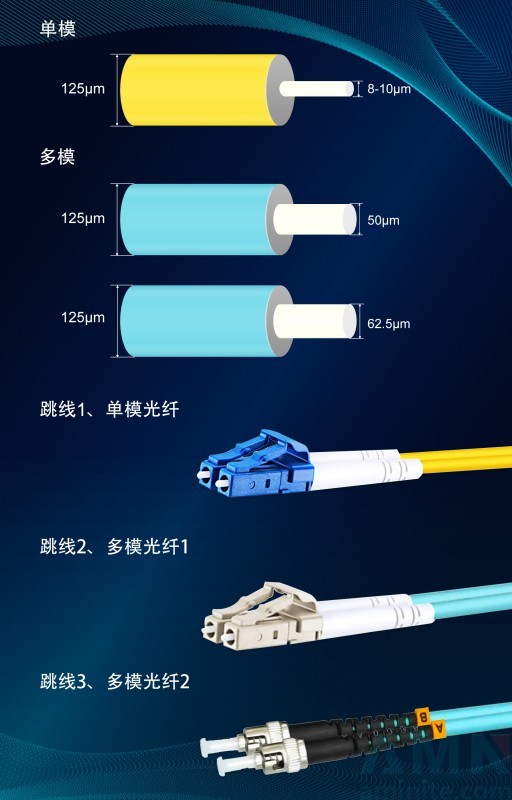The concept of single-mode and multi-mode is the concept of propagation mode of multi-mode fiber and single-mode fiber. The term “mode” is used to describe how the optical signal propagates in the fiber glass core. In a single-mode fiber, light travels along one path; in a multi-mode fiber, light travels in multiple paths.
①Core diameter
Single-mode fiber: typical single-mode fiber has a core diameter of 8 and 10 µm, and a cladding diameter of 125 µm;
Multimode fiber: The usual multimode fiber has a core diameter of 50 and 62.5µm, and a cladding diameter of 125µm;
②Color:
Single-mode fiber: The color of the general fiber jumper is yellow, and the connector and protective cover are blue;
Multimode fiber: the color of the general fiber jumper is aqua green, and the connector and protective cover are beige or black;

multi-mode & fiber single-mode fiber
③Light source:
Single-mode fiber: using a laser as the light source, the light generated by the laser light source is a single light, which can be precisely controlled and has high power;
Multimode fiber: Use LED as the light source, the light generated is relatively scattered;
④ Modal dispersion:
Multimode fiber: LED light source is used in multimode fiber to create a series of wavelengths that propagate at different speeds. This will cause multi-mode dispersion, which limits the effective transmission distance of multi-mode fiber jumpers;
Single-mode fiber: The laser used to drive a single-mode fiber produces a single wavelength of light, so its modal dispersion is less than that of a multi-mode fiber;
⑤Bandwidth:
Since multimode fiber has a larger core size than single mode fiber, it supports multiple transmission modes, and the modal dispersion of single mode fiber is less than that of multimode fiber. For these reasons, single-mode fiber has a higher bandwidth than multi-mode fiber.
⑥Price:
Single-mode fiber: The price is lower than that of multi-mode fiber, but the equipment of single-mode fiber is more expensive than that of multi-mode fiber, and the cost is higher than that of dual-mode fiber.
Multi-mode fiber: The price is higher than single-mode fiber. Multi-mode fiber equipment is cheaper than single-mode fiber equipment. Therefore, the cost of multi-mode fiber is much less than the cost of single-mode fiber.
⑦Transmission distance:
Single-mode fiber: Single-mode fiber runs at a data rate of 100M/s or 1G/s, and the transmission distance can reach at least 5KM. Normally, single-mode fiber is used for long-distance signal transmission;
Multimode optical fiber: Multimode optical fiber is mainly used for short-distance optical fiber communication, such as in buildings or campuses. When the transmission speed is 100M/s, the transmission distance is up to 2km.

